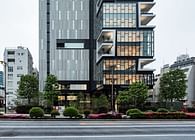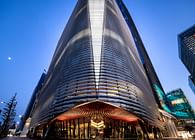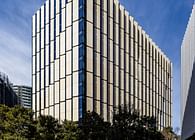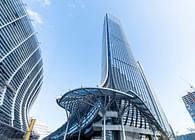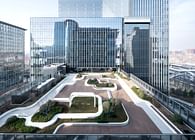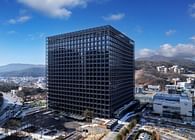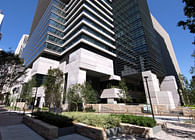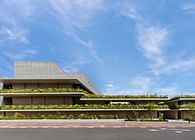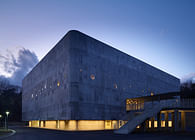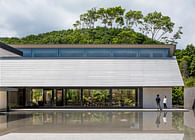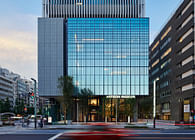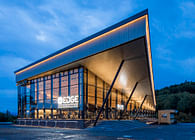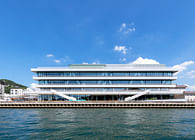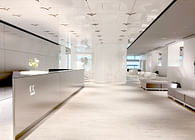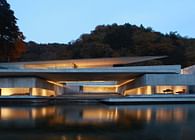
Realizing an all-concrete auditorium
The Waseda University Senior High School Auditorium is the centerpiece of a lush green campus located in the suburbs of Tokyo, located in a typical residential area populated with two-story homes. This project was part of a reconstruction scheme to replace aging facilities damaged by the Great East Japan Earthquake of 2011. Befitting of the school spirit slogan “simplicity and fortitude,” the aim was to create an auditorium (also used as a music hall) where the floor, walls, and ceiling are made entirely out of concrete – a “pure” hall with only two layers of concrete boxes.
Concrete was selected as the primary material for sound insulation, structural rationality, and visual harmony with the pre-existing school buildings. Designers were also compelled to comply with legal restrictions on buildable area and height. To accommodate the 1,500-person capacity, the building’s foyer was externalized using pilotis which extend continuously to the adjacent gymnasium and classroom building. This arrangement plays an important role in making the entire facility look like an integral part of the campus, rather than a conspicuous, newly added component.
Integrating acoustics, design, structure, and functionality
The auditorium (music hall) is used for various activities, including student body assemblies, presentations, ceremonies, lectures, plays, concerts, and practice sessions, with each use case requiring different acoustic, lighting, and air conditioning requirements. The concrete walls and ceiling are divided into 1500mm square sections, or panels, each with an open, triangular-shaped corner. These openings serve three purposes: to absorb and diffuse sound waves (via inner double walls), facilitate air venting, and allow for maintenance and access to lighting, firefighting, and acoustics equipment.
The panel surfaces are slightly angled, and each comes with a different handcrafted surface finish. In all, more than 10 different types of finishes were employed, including “polished,” “bush hammered,” “waterjetted,” “sandblasted” and “scratched.” Extensive simulations were used to determine the ideal combination of these sections in order to suit the widest possible range of acoustic requirements, obviating the need to alter basic sound equipment settings.
The spartan interior is uncluttered, with no painted surfaces and no distracting decorative appointments. This feature is consistent with traditional Japanese-style interior design, and the singular use of concrete reduces the cost of upkeep. The seating area is designed to provide the best acoustic environment for each and every person in the audience, forming a sense of unity among the 1,500 high school students.
Capturing the spirit of Michelangelo
The design and engineering aspects of the auditorium – especially the variegated panel arrangements and differences in the hue of the concrete -- lend a subtle, spiritual aspect to the overall interior design. The project’s chief Nikken Sekkei architect references the spirit of Michelangelo and the renowned Sistine Chapel illustrations in his vision for the facility. The craftsmanship put into finishing each concrete panel after casting (even the ceiling sections), evoke a chapel-like atmosphere of solemnity and strength for the students and faculty who make use of it.
Project name: Waseda University Senior High School Auditorium
Purpose: Senior high school (educational facility)
Location: Nerima-ku, Tokyo
Site area: 57,558.34 square meters
Total floor area: 2,412.52 square meters
Number of floors: two above ground
Eave height/maximum height: 10.96m / 14.21m
Main structure: reinforced concrete, part steel
Completion month/year: July, 2014
Status: Built
Location: Tokyo, JP
Firm Role: Lead Architect (Schematic design, design development, construction documentation, construction contract administration)
Additional Credits: Construction Contractor: TOKYU CONSTRUCTION CO., LTD.
